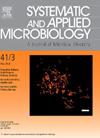Carnimonas bestiolae sp. nov. and Cernens ardua gen. nov., sp. nov.: new halotolerant bacteria from the invasive solitary bee Megachile sculpturalis
IF 4.2
2区 生物学
Q2 BIOTECHNOLOGY & APPLIED MICROBIOLOGY
引用次数: 0
Abstract
Fifteen isolates from gut samples of the invasive solitary bee Megachile sculpturalis remained unidentified after matrix-assisted laser desorption/ionization time-of-flight mass spectrometry analysis. Phylogenomic and overall genome relatedness indices analyses of five representative isolates demonstrated that 14 isolates represented a novel Carnimonas species for which we propose the name Carnimonas bestiolae sp. nov., with LMG 33810T as the type strain. A single isolate represented a distinct lineage within the Halomonadaceae family with the genera Carnimonas and Halotalea as nearest neighbor taxa and is classified as Cernens ardua gen. nov., sp. nov., with LMG 33818T as the type strain. Comparative genomic analysis and physiological characterization revealed functional differences between C. bestiolae, Ce. ardua and established Carnimonas and Halotalea species in central metabolism, fatty acid metabolism, and osmoregulatory pathways, the latter being consistent with adaptation to a saline environment. A reanalysis of previously published insect microbiome studies in which Carnimonas was reported, revealed 16S rRNA amplicon sequence variants with >99 % identity to C. bestiolae LMG 33810T 16S rRNA in gut samples of Megachile sculpturalis, Anthidium florentinum, and the psyllid Leptynoptera sulfurea. In contrast, 16S rRNA amplicon sequence variants corresponding to Ce. ardua were rarely detected and only at low relative abundances, suggesting a transient association with the insect gut.
牛膝单胞菌(Carnimonas bestiolae sp. 11 .)和牛膝单胞菌(Cernens ardua gen. nov., sp. 11 .):来自入侵独居蜜蜂巨蜂的耐盐新细菌
基质辅助激光解吸/电离飞行时间质谱分析显示,15株入侵独居蜂(Megachile sculpturalis)的肠道样本尚未被鉴定。对5个代表性分离株的系统基因组学和全基因组相关性分析表明,其中14个分离株为一种新的卡尼单胞菌,我们将其命名为卡尼单胞菌bestiolae sp. nov.,并以LMG 33810T为型菌株。单株分离菌株与Carnimonas属和Halotalea属有明显的亲缘关系,属Cernens ardua gen. nov., sp. nov., LMG 33818T为类型菌株。比较基因组分析和生理特性分析表明,双歧杆菌、大肠杆菌和大肠杆菌在功能上存在差异。并在中枢代谢、脂肪酸代谢和渗透调节途径中建立了Carnimonas和Halotalea两个物种,后者与适应盐碱环境一致。对先前发表的关于Carnimonas的昆虫微生物组研究的重新分析显示,在巨型雕塑菌、花栗蚁和细翅虫的肠道样本中,16S rRNA扩增子序列变异与C. bestiolae LMG 33810t16s rRNA具有99%的一致性。相比之下,16S rRNA扩增子序列变异对应于Ce。Ardua很少被检测到,而且相对丰度很低,这表明它与昆虫肠道有短暂的联系。
本文章由计算机程序翻译,如有差异,请以英文原文为准。
求助全文
约1分钟内获得全文
求助全文
来源期刊

Systematic and applied microbiology
生物-生物工程与应用微生物
CiteScore
7.50
自引率
5.90%
发文量
57
审稿时长
22 days
期刊介绍:
Systematic and Applied Microbiology deals with various aspects of microbial diversity and systematics of prokaryotes. It focuses on Bacteria and Archaea; eukaryotic microorganisms will only be considered in rare cases. The journal perceives a broad understanding of microbial diversity and encourages the submission of manuscripts from the following branches of microbiology:
 求助内容:
求助内容: 应助结果提醒方式:
应助结果提醒方式:


